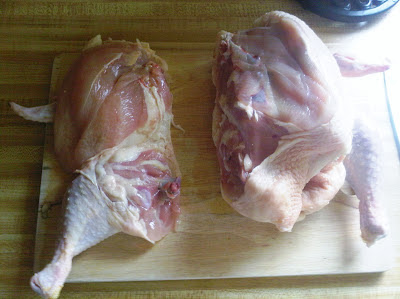Here's the old bird herself. Lay her down on her back with her breasts up(insert joke of choice here...).
To the left or the right of the breast bone(located in the middle), slice the breast away from the bone. You'll want to have a nice sharp boning knife and try and make sure to leave as little meat on the carcass as possible. This will most likely take you several times to get good at but eventually you'll get the feel for it.
Here's the first breast sliced away from the carcass.
Once you get the first breast close to being off, you now have to work on the leg. Most of the time you can pull back on the leg and the bone will pop out of the socket revealing right where you need to cut.
With the leg off, go back up to the breast and you'll see where the wing bone is attached to the body. Slice right between the socket and you can cut away the breast.
On the left, you now have half a chicken.
Repeat the same process on the opposite side and you'll have your other half.
Take one side of the chicken and grab the wing. Pull back slightly on the wing and you'll find that the socket that holds the wing to the drumette will be exposed. Slice right between them to remove the wing.I always trim off the little tiny piece on the wing that has very little meat and add it to stock.
Here the wing has been removed from the drumette.
Between the breast and thigh, you'll see that there is no meat, only skin. Slice between them and you'll now have your two half's-breast and drumette and thigh and leg.
Place the breast skin side down and slice the drumette away from
the meat of the breast.
Drumette removed.
Here is all of your pieces from half the bird once you sectioned them out. I have taken the skin off of the chicken(bottom left) and removed the tender from the breast(top right).
Once you have both sections of the bird removed, you now have the carcass left. I'll trim off any excess fat that's hanging onto it as it will help to make for a clearer stock and you'll have less to skim off of the top.
Next you need to get your mirepoix cut. For one carcass, I'll use half a medium size onion, 2 stalks of celery, and about 3-4 medium sized carrots. If you wash the carrots well, you can leave the skin on. It will make for a little earthier flavor. I always peel mine but it's up to you.
Now for the cutting. I always make my carrots a little smaller as their more dense and take longer to break down. I cut my celery and onions bigger as they break down quicker. Cutting them this way makes sure that all the mirepoix breaks down at the same time.
Over medium heat and using a little oil, sweat your mirepoix out until it's soft and just starts to caramelize.
While the mirepoix is sweating, get your aromatics together. Bay leaves, black peppercorns, and fresh thyme are the three I always add. If you have it, you can throw in a sprig or two of fresh rosemary or some parsley stems.
Once the mirepoix is sweated out, add the chicken carcass and enough water to cover. Bring it to a boil and then reduce to a slow simmer skimming the top for fat.
Once the fat is removed, add your aromatics and let it go for about 2 hours.
Strain out the stock through a fine mesh strainer.
Now you have a nice golden stock! If you can see a lot of fat still left on the surface, put the stock in the fridge overnight. By morning, all the fat will have congealed on the top and you can scoop it right off. Next I'll show you what you can do with your stock.






















No comments:
Post a Comment